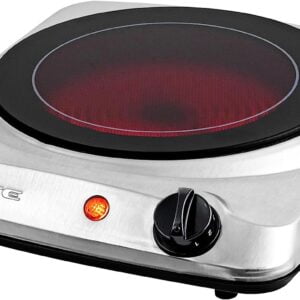The Ultimate Guide to Single Burner Outdoor Stoves: Compact Cooking Power for Outdoor Adventures
Single burner outdoor stoves are a versatile and efficient solution for outdoor cooking, catering to the needs of campers, backpackers, hikers, and anyone who enjoys outdoor adventures. These compact stoves provide a reliable heat source for boiling water, cooking meals, and preparing hot beverages, all while being portable enough to fit into your backpack.
Features and Benefits:
Portability: The primary advantage of a single-burner outdoor stove is its portability. These stoves are designed to be lightweight and compact, making them easy to carry during outdoor activities. They take up minimal space in your backpack, leaving you with more room for other essentials.
Fuel Efficiency: Single burner stoves are designed to be fuel-efficient, helping you make the most of your fuel supply during extended trips. They typically use propane or butane canisters as fuel sources, both of which are readily available in camping and outdoor stores.
Quick Setup and Ignition: Most single-burner outdoor stoves have a simple and user-friendly design. Setting them up and igniting the stove is usually a hassle-free process, allowing you to start cooking quickly.
Stability: While single burner stoves are compact, they are also built to provide stability during cooking. Look for models with sturdy legs and wide bases to ensure the stove stays secure on uneven terrain.
Adjustable Flame: Many single burner stoves come with adjustable flame control, allowing you to regulate the heat output for precise cooking. This feature is especially useful for simmering or when you need a low heat setting.
Wind Protection: Some models include built-in windshields or offer accessories to protect the flame from wind, which can be extremely beneficial during outdoor cooking.
Tips for Using Single-Burner Outdoor Stoves:
Choose the Right Fuel: Before your trip, decide on the type of fuel you’ll use – propane or butane canisters are the most common choices. Check the compatibility of your stove with the fuel canister, and bring along an extra canister if you expect to cook for an extended period.
Practice at Home: Familiarize yourself with the stove’s setup and operation before heading outdoors. Practice igniting the stove, adjusting the flame, and attaching the fuel canister to gain confidence in using the equipment.
Plan Your Cooking: Plan your meals ahead of time to ensure you have all the necessary ingredients and cooking equipment. Single burner stoves are limited in space, so consider one-pot meals or dishes that require minimal preparation.
Cook in a Safe Area: Always place your single burner stove on a stable and level surface. Avoid setting up the stove too close to flammable materials, and never use it inside a tent or enclosed space.
Use Wind Protection: If your stove doesn’t come with a built-in windshield, consider bringing an accessory to shield the flame from wind. This will improve fuel efficiency and cooking performance in breezy conditions.
Clean and Maintain: After each use, clean the stove, removing any food particles or debris. Regularly inspect the stove for any signs of damage or wear, and replace worn-out parts if needed.
Conclusion:
Single burner outdoor stoves are a must-have companion for outdoor enthusiasts looking to enjoy delicious hot meals while on the go. With their compact design, fuel efficiency, and ease of use, these stoves elevate the outdoor cooking experience to a whole new level. Whether you’re camping, hiking, or embarking on a backpacking adventure, a single-burner outdoor stove ensures you can savor the joy of cooking in the great outdoors. Just remember to choose the right fuel, practice using the stove beforehand, and cook responsibly in safe outdoor environments. Happy outdoor cooking!



